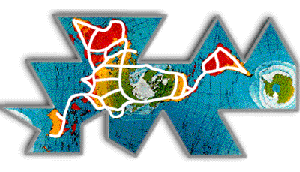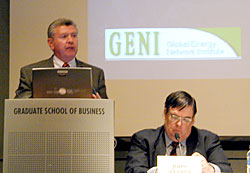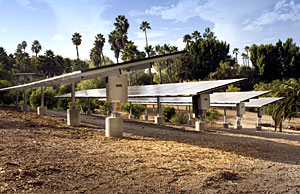Fighting Climate Change, Expert Says
STANFORD, Calif., -– The key to fighting climate change is for the U.S. to take a leadership role in promoting a “new world wide web of electricity,” according to Michael Powers, board member and spokesman for Global Energy Network Institute, a non-profit research and education group based in San Diego.
Powers made the comments at Stanford University’s recent conference, “Energy in the Developing World: Working toward a Sustainable Future.” The conference was organized by the Stanford Association for International Development (SAID) and the Graduate School of Business.
“By connecting regional electricity grids around the world into a global network, it will be possible to tap new renewable resources and phase out our worst polluting coal-fired power plants,” Powers said.
Pointing out that "enough solar energy falls on the surface of the earth every 40 minutes to meet 100 percent of the entire world's energy needs for a full year," Powers said the problem confronting mankind is not “insufficient energy,” but “too much energy of the wrong kind, in the wrong place, at the wrong time.” As a result, he said, the energy challenge is “not a supply problem but a distribution problem.” This, he said, is where the global network comes in.
In most cities, the need for electricity changes drastically throughout the day -- from a low after midnight to an afternoon peak (usually half again as high as the low point).
Today, about 2,800 power plants in the U.S. must be turned on and off to meet local energy needs. Together, they produce 40% of the U.S. carbon dioxide emissions, along with 18% of the nitric oxide and 60% of the sulfur dioxide emissions.
“The alternative is for power companies to move excess power from one time zone to another because that’s often cheaper than turning generators on and off just to meet peak demand,” Powers said, pointing out that over 35% of all power sold in the U.S. is now composed of bulk power transfers.
 With
a larger and more robust “backbone” for energy transfers, such trading
could happen at the global level – for instance, between time zones in
the U.S. and in China. Studies show China is set to pass the U.S. as the
largest emitter of CO2 in the world and is building the equivalent of a
new 1,000 MW power plant per week – all coal-fired.
With
a larger and more robust “backbone” for energy transfers, such trading
could happen at the global level – for instance, between time zones in
the U.S. and in China. Studies show China is set to pass the U.S. as the
largest emitter of CO2 in the world and is building the equivalent of a
new 1,000 MW power plant per week – all coal-fired.
“Instead of running all of the world’s generators’ half the time – which is very inefficient – we are talking about running half the world’s generators all the time… much more efficient,” Powers said.
It is a common misconception that long-distance energy transfers are impractical, Powers said, explaining that in the 1930’s there was a transmission limit of 350 miles. “That limit grew to 1,500 miles in the 1960’s and is now well over 4,000 miles using Ultra-High Voltage and High-Voltage Direct Current (HVDC) technology,” he said.
In fact, southern California gets a hefty portion of its electricity from 1,000 miles away – via a single HVDC line connecting it to hydro power from Oregon, enough to run 2-3 million homes. “Distance is not a barrier,” he asserted.
A far larger barrier is the state of the electric utility industry. “The industry is mainly regional in scope, highly-regulated throughout its history and with no incentive to invest in new transmission lines or long-distance infrastructure,” Powers said.
Despite this fact, well
over half of the transmission systems for a global energy network are already
in place, Powers said, and new international grid connections throughout
the world are gaining in momentum.
are already
in place, Powers said, and new international grid connections throughout
the world are gaining in momentum.
“Last year was a banner year for global interconnections,” Powers noted, reeling off a list of new trading partners for electricity such as Russian and China, China and Vietnam, Kenya and Ethiopia, and a new Mediterranean power pool which will reportedly link the countries of Egypt, Jordan, Syria, Turkey, Libya and Iraq.
“Even countries lacking diplomatic connections can still see the advantage of electrical connections,” Powers explained. “Or, at least, their power engineers clearly do.”
A key connection still to be built is the “East-West Energy Bridge” which would connect Alaska to Siberia via two 20-mile links across the Bering Straits. “This is the crucial gateway to the 11 time zones of the former Soviet Union and also the new powerhouse of China.”
Closer to home, the California Solar Initiative (CSI) plans to bring thousands of new solar energy systems online during the next 10 years and each of these systems represents a “new node on the global network,” Powers said. “We are creating a new market segment of ‘pro-sumers’ – energy producers during the daytime and consumers at night,” he said, He argues that this will launch a whole new industry of to supply equipment and software for managing this energy and tracking renewable energy transactions.
 “Imagine ‘Napster' for solar energy,” Powers said. “We’re talking about peer-to-peer energy trading...
where a solar homeowner in San Jose can capture kilowatts from the sun
– and sell them to a homeowner in Shanghai – instantaneously. That’s the
future.”
“Imagine ‘Napster' for solar energy,” Powers said. “We’re talking about peer-to-peer energy trading...
where a solar homeowner in San Jose can capture kilowatts from the sun
– and sell them to a homeowner in Shanghai – instantaneously. That’s the
future.”
Powers said the concept of a global energy network was first proposed by Dr. R. Buckminster Fuller – the inventor of the geodesic dome, among other things – at a series of simulation workshops called “World Games” conducted in the 1970’s.
“As Fuller and his students pointed out during the World Games, electricity is the basis of our modern standard of living but even today, almost 2 billion people do not have access to any electricity,” Powers explained. “As a result, 18,000 children die from preventable starvation daily – that’s about equal to the enrollment of Stanford University, every single day,” he said.
“The vision offered by a global energy network is a reduction in poverty and hunger, a way to stabilize population growth, to turn back the clock on global warming and to phase out fossil fuels… while increasing trade, cooperation and peace between nations,” he concluded.
Michael Powers is VP Sales & Marketing and co-founder of Stellar Solar, which supplies PV solar energy systems in San Diego. In 2001, he helped launch The Home Depot’s national solar energy program. He is a writer and marketing professional with over 30 years’ experience and currently serves on the board of Global Energy Network Institute (GENI), a non-profit organization he has avidly supported since 1986.
Global Energy Network Institute is a not-for-profit research and education, founded in 1986 by its current President, Peter Meisen, to investigate the idea of Dr. R. Buckminster Fuller, proposing a global electric energy grid as the number one priority to solve many of the world's most pressing problems.
# # #
For more information, contact michael@terrawatts.com.